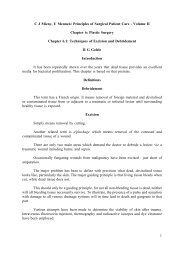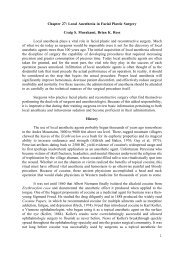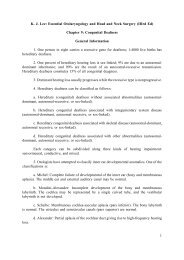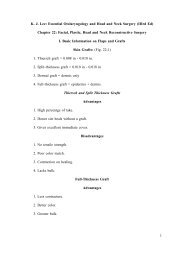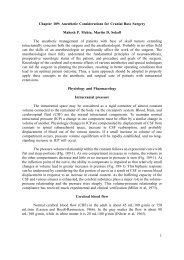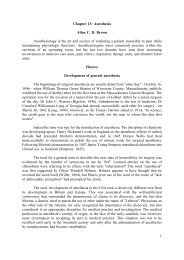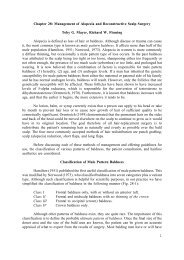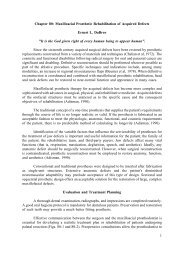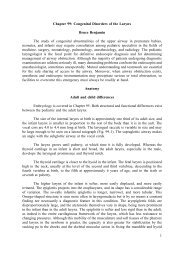1 Chapter 8: Skin Flap Physiology George S. Goding ... - Famona Site
1 Chapter 8: Skin Flap Physiology George S. Goding ... - Famona Site
1 Chapter 8: Skin Flap Physiology George S. Goding ... - Famona Site
You also want an ePaper? Increase the reach of your titles
YUMPU automatically turns print PDFs into web optimized ePapers that Google loves.
Microspheres are polystyrene beads of uniform size with isotopes placed inside. For<br />
measurement of capillary perfusion the beads are typically 15 microm in size to allow<br />
trapping in the capillary beds but passage through A-V shunts. Larger microspheres (50<br />
microm) can be used if trapping in the A-V shunts is desired. Microspheres are injected into<br />
the left ventricle, where they are mixed before being expelled with the blood and trapped in<br />
the tissue capillaries. The ratio of the blood flow in a specific tissue to the cardiac output<br />
equals the ratio of the number of microspheres trapped in that tissue to the total number of<br />
spheres injected. A blood sample is drawn at the time of microsphere injection to serve as a<br />
reference for calculating cardiac output and blood flow to the tissue being investigated (Pang<br />
et al, 1984).<br />
The microsphere technique was found to be linearly correlated with blood flow to the<br />
skin (Pang et al, 1984). When skin blood flow was low (approximately 0.03 mL/min), the<br />
repeatability of the technique was hindered. A blood flow this low is rarely seen in acute<br />
random flaps and would occur only when arterial spasm is at a maximum in the early<br />
postoperative period. By using different sets of microspheres, capillary blood flow can be<br />
measured simultaneously and consecutively to skin, muscle, and bone. A major disadvantage<br />
preventing its clinical use is the need to sample the tissue at the end of the experiment.<br />
Fluorescein<br />
Many vital dyes are available, including bromphenol, disulphine, patant blue, vicodan,<br />
and xylenol orange, but fluorescein is used most often. Sodium fluorescein dye (C 20 H 10 Na 2 O 5 ;<br />
molecular weight 376.3) is nontoxic at pharmacological doses of 10 to 15 mg/kg (Pang et al,<br />
1986a). LD-50 is 1000 mg/kg in laboratory animals. When exposed to ultraviolet light (< 510<br />
nanom), the dye will emit a yellow-green fluorescence. After intravenous injection the<br />
fluorescein moves quickly from the intravascular compartment to the extracellular space<br />
without penetrating the cell membranes. Staining occurs in tissues with a nutrient blood flow.<br />
Fluorescence can be detected visually with a Wood's light, photographically with the<br />
appropriate filters, or with a dermofluorometer.<br />
The visual fluorescein test is performed with a Wood's light, and the length of<br />
fluorescein staining is observed. With fluorescein photography a blue filter is placed over the<br />
flash and a yellow filter is placed over the lens. Both techniques require a relatively large<br />
dose of fluorescein (15 to 30 mg/kg). This dose can take 12 to 18 hours to clear, which limits<br />
how often the test can be performed. Both techniques are more difficult to perform in highly<br />
pigmented skin.<br />
Lower doses of fluorescein (1.5 mg/kg) can be used with a fiberoptic<br />
dermofluorometer. The dermofluorometer uses a fiberoptic cable to carry the ultraviolet light<br />
to the skin and transmit the induced fluorescence to a photodetector. A numerical output is<br />
generated, which can be read off the machine. For each estimation of blood flow, the skin<br />
fluorescence before and after fluorescein injection is measured. The rise in fluorescence of<br />
the skin under investigation and in a reference area are compared, and a dye fluorescence<br />
index (DFI) is calculated. By quantifying the fluorescence and lowering the fluorescein dose,<br />
blood flow can be examined at more frequent intervals.<br />
12




